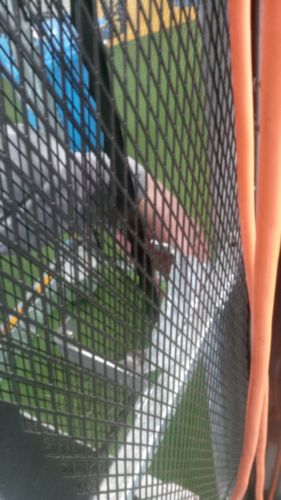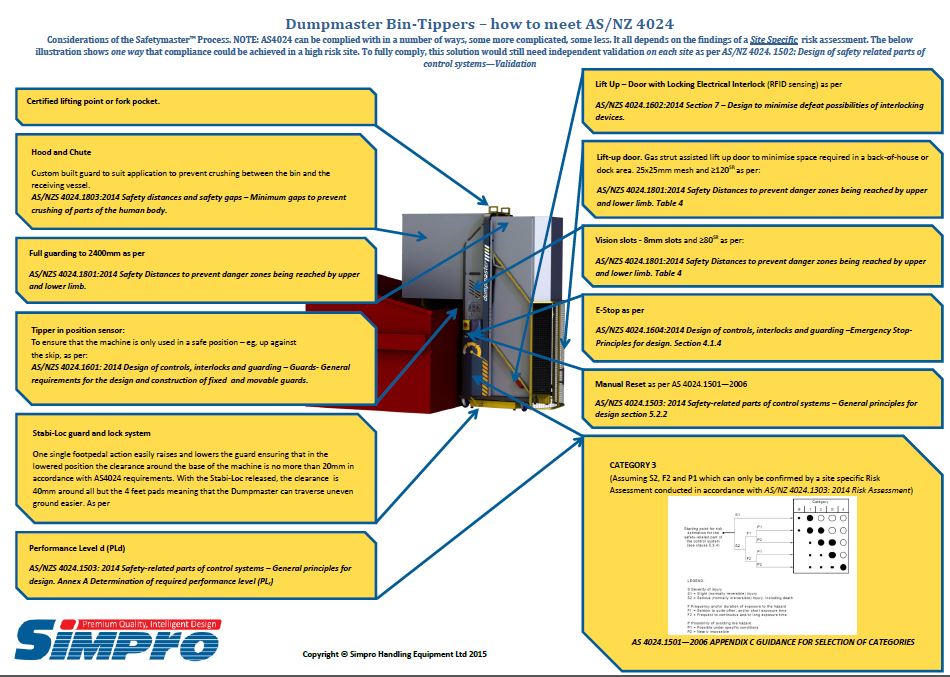
The hazards of implementing AS/NZS 4024:2014
An understanding of safety standards is essential for owners or purchasers of workplace machinery.
Introduction
Companies in Australia and New Zealand are required by law to provide a safe workplace for their staff, including ensuring that all new and existing machinery is safe for staff to operate. This requirement is set out by Workplace Health and Safety legislation in both countries, and the penalties for non-compliance are severe, extending to jail terms. These laws and their supporting documents make frequent reference to a standard called AS/NZS 4024:2014 'Safety of Machinery'.
AS/NZS 4024:2014 gives detailed guidance on how to ensure that workplace equipment has a suitable level of safety control measures. Like all standards, it is a 'living document' and subject to change over time as new information and technology becomes available. The 2014 version has significant changes from the previous version released in 2006.
Because AS/NZS 4024:2014 is a legal requirement it is often assumed to be straightforward to implement - unfortunately this is not the case!
Implementing AS/NZS 4024:2014
The most widely known procedure of AS/NZS 4024:2006 was the calculation of the 'Category Level' required by the safety system architecture. This has been replaced in AS/NZS 4024:2014 with the calculation of the 'Performance Level' and although there are similarities, there are also many differences.
Essentially, 'Performance Level' is much more comprehensive than 'Category Level'. It requires that procedures be developed for every phase of a machine’s life cycle, from design through to decommissioning, to ensure potential hazards are suitably controlled. All of these procedures must be documented to demonstrate that due process has been followed.
Safety standards are usually referred to by their abbreviations, such as 'Cat3' for Category Level 3, or 'PLd' for Performance Level d.
The Issues
Many companies still have little understanding of what is required by AS/NZS 4024:2014, or the documentation and costs involved. Equipment is often marketed as 'Cat3-compliant' without making clear this does not necessarily mean it meets the AS/NZS 4024:2014 standard, or even the 2006 edition. In certain cases Cat3 itself is not completely implemented.

Unfortunately, because the requirements are so complex, few prospective buyers are able to to verify a machine does in fact meet the standards that are claimed. Acquiring the necessary understanding of AS/NZS 4024 and Cat3 requires time and money, as well as specialist training.
The consequences of this mutual lack of understanding can be very significant. An employer may be prosecuted following a serious harm incident if it is found that due process was not followed in providing safe and compliant machinery. This means the employer is responsible for the safety of their equipment - a supplier's statement of compliance is not necessarily sufficient in the eyes of the law.
The employer has a legal responsibility to verify that not only is their machinery truly safe and compliant, but safe in their own environment and conditions of use.
Although the procedures are set out in AS/NZS 4024:2014, it is very difficult for a layperson to grasp all the implications of this complex standard. Anyone involved in the purchase of certified industrial equipment (for example with Cat3 safety) should review if they truly understand what is required, and consider getting advice from a qualified specialist before committing to any purchase.
Purchasing Equipment
Any supplier of industrial machinery should be able to provide the following documentation on request:
- A comprehensive Hazard & Risk Assessment (conducted as if there were no guards at all on the machine)
- Hazard mitigation strategies
- Analysis of foreseeable use and misuse
- Documentation of all safety-related parts
- Wiring and circuit diagrams
- Analysis of how the proposed mitigation strategies will provide acceptable risk control for all hazards
- Documentation of residual hazards and what steps the end-user should take to isolate them
- Operations Manuals
- Service and Maintenance Manuals
Proposals should include this documentation, and it should be reviewed before placing an order. This allows the purchaser to take an informed decision on whether the provided safety features are suitable for their specific environment and intended use.
Once a machine is delivered it should be formally inspected to ensure that every safety function works exactly as intended, and there are no loopholes that might allow those functions to be bypassed.
Finally, there should be documented evidence that the machine has been verified by an independent, qualified specialist to fully comply with the relevant standards.
This process is time-consuming and expensive, and the equipment required to ensure compliance is also expensive and complex. If a proposal for AS/NZS 4024:2014 compliant equipment is not noticeably more expensive than a non-compliant solution, it should be investigated in detail - there have quite likely been shortcuts taken on lawful requirements. Suppliers quoting on compliant machinery must be able to present documented evidence of that compliance.
Conclusion
AS/NZS 4024:2014 Category 3 and 4 requirements are complex and expensive, and there are no shortcuts. Purchasers cannot necessarily take a supplier’s word that their equipment does in fact comply, and great care must be taken unless one has a thorough understanding of the standards. In the event of a Serious Harm Incident, the machinery purchaser may be required to testify that they were qualified to take decisions regarding safety and compliance.

There are many different approaches to delivering workplace safety, but the full standards process must be followed to claim protection before the law. Simpro has developed a process-driven system to ensure the safety and compliance of our machines, called Simpro SafetyMaster™. Some typical SafetyMaster™ design considerations can be viewed here.
Before investing in workplace machinery, Simpro strongly recommends that purchasers seek qualified, specialist advice on AS/NZS 4024:2014 compliance. This will not only help to keep your staff safe, it will protect you from litigation should an accident unfortunately occur.
Please remember that this article is an overview only, and must not be considered a comprehensive guide to workplace safety compliance.